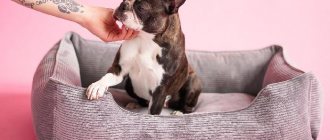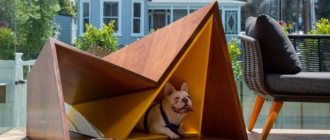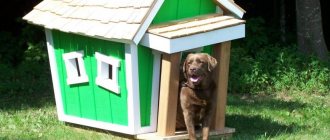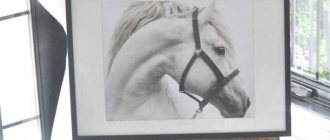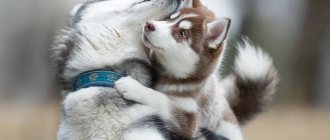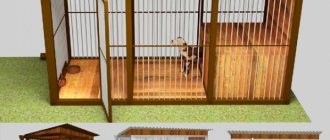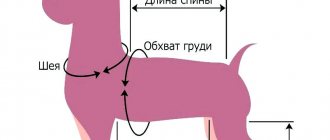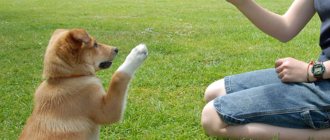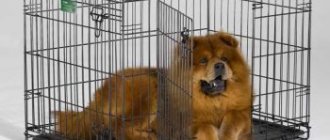Before you start setting up a dog house outside, you should take into account the climate of the country. Not every breed is suitable for living outdoors. Even if the dog is adapted to harsh winters, its kennel must be insulated. Another important point for the safe living of a dog in a kennel is its bedding.
There are general tips for choosing and arranging bedding for your four-legged friend:
- It is necessary that the bedding matches the size of the dog. To do this, you need to know the height and length of the dog. Height is measured from the front foot to the top of the head, and the distance from the nose to the tail of the dog will be its length. If the bedding is too close in size, it will be very uncomfortable for your pet to sleep, as it will not fit and will partially lie on the floor. It is also possible that the dog will generally pull the bedding out of the kennel and refuse to sleep on it;
- It is desirable that the bedding be made of a material that can be easily washed, cleaned of hair and dust, and that reflects the dog’s body temperature. Chemicals must not be used due to the high sensitivity of dogs' sense of smell;
- The threads and material for the bedding must be dense and wear-resistant so that your four-legged friend cannot tear it;
- You cannot decorate the litter with ribbons, ribbons, bows and beads. Most likely, the dog will tear off the jewelry on the first day. You can decorate the litter with a sewn applique;
- For dogs with short hair, soft bedding is more suitable to avoid scuff marks on the fur.
How to accustom a dog to a bed?
Dog
hold by the collar, place the treat on
the bedding
and, making sure that the pet sees the treat, take it 1-1.5 meters away.
Then they say “Place!” and release the animal. When the dog
takes the treat, he is praised. This stage is repeated 5 times, gradually increasing the distance to the litter to 7-10 meters.
Interesting materials:
How to start a car battery? How to run GTA 5 on a discrete graphics card? How to start a broadcast on Twitch? How to start a broadcast on twitch? How to start a broadcast on Twitch? How do bloggers make money on YouTube? How to make money from advertising on YouTube? How to make money by taxi? How to earn diamonds in Hay Day farm? How to earn League medals in Clash of Clans?
Materials used for bedding
For optimal conditions for keeping your four-legged friend outdoors, it is necessary to build a good quality enclosure or kennel, taking into account all the physiological characteristics and needs of the dog. The building must be reliably insulated. It is also necessary to equip a special place where bedding material will be stored. There should be no moisture or rodents there. You also need to think about a place suitable for feeding your pet. It should not be in the open air. When all this is prepared, you need to think about the material for the bedding. A dog that lives in a kennel needs good bedding. It should not only be warm, but also soft, comfortable and safe for health. Not all materials meet these requirements.
All materials that can be used as bedding have their own nuances, features, positive and negative sides. However, no matter what you choose, the main condition should be the dryness of the litter. If your pet has a thick undercoat, then she will be able to withstand severe frosts.
There are dogs that do not need bedding at all. They just pull it out of the box, regardless of the material from which it is made. But constant drafts, moisture and dampness can cause irreparable harm to a dog’s health.
So, what can you put on the floor of a dog's kennel? Most often used:
- Straw and hay;
- Mattresses and other fabric bedding;
- Wood shavings and sawdust;
- Buckwheat husk.
Dog at home, on a chain (leash), photos 8 and 9.
More often than not I saw just such a picture. A dominant one-year-old male Central Asian Shepherd, Jamal, before our training began, lived on a closed veranda in the house until he began to attack the owners’ guests.
An enclosure was built for the Central Asian shepherd dog Jamal where a car was parked.
He categorically refused to enter the booth. His enclosure was placed in the place of the car that is visible in the background of the photo.
Labrador Jerry lived on a leash on the veranda
And the magnificent retriever Jerry lived on the open veranda of the rented house while the owners built their cottage.
Buckwheat husk
Among all the bedding options, there are also those with buckwheat husk filling. They are useful for sick animals. Ticks, fleas and other harmful insects will never grow in such bedding. They are well ventilated. Buckwheat husk bedding keeps you cool in the summer and warm in the winter. They are resistant to moisture and do not clump.
Frost-resistant, wear-resistant, retains heat, easy to care for, dries quickly, hypoallergenic, does not absorb dirt
Most often, dogs are bred for the purpose of protection, so they are kept on the street. Some owners believe that their pet will be quite comfortable living just in an enclosure. Other more caring dog breeders place their four-legged friends in a kennel. Of course, for harsh winters, the dog’s outdoor home must be insulated. When it comes to insulation, what the dog will sleep on, that is, the bedding in the kennel, plays an important role.
The main requirement for bedding for a dog in a kennel is the absence of moisture, because in combination with winds and cold weather it can have serious consequences for the pet.
It is very important that your pet likes the bedding in the kennel for the winter. Dogs may tear it to shreds or simply avoid it. That is why you should take a responsible approach to choosing a product.
Outdoor aviary 4. Lightweight, portable aviary design made of metal.
The aviary is convenient because it allows the owner to determine the most convenient place for him on the estate.
This outdoor enclosure does not have a run
This enclosure is also characterized by a frequently encountered drawback - the lack of walking for the dog, which, however, can be easily corrected by finally deciding on the final location of the enclosure on the estate.
Outdoor enclosure 5. Correct, simple, no frills.
The enclosure was built correctly. There is a walking compartment. The door opens inward and presses against the partition, without dangling or interfering with training and cleaning the room, as can be seen in another photo.
A properly constructed outdoor enclosure
The front grill of the enclosure can be closed with a drop-down curtain (in the photo the curtain is rolled up).
Outdoor aviary. A trained dog sits at the booth and does not interfere with cleaning the enclosure and walking compartment
Hay and straw
If your four-legged friend lives in outdoor conditions, then it is highly undesirable for him to use hay or straw as bedding. There is a high chance that your pet will become infected with parasites such as fleas and ticks. In addition, all organic litter is characterized by the presence of enterobacteria: intestinal bacteria, salmonella. Also in straw and hay there are intestinal eels, which cause a wide variety of diseases in dogs. Another significant disadvantage of these materials is that they cannot be disinfected.
However, despite all the dangers and warnings, many owners like to use hay and straw as bedding. They motivate this by the fact that these materials are environmentally friendly, have a pleasant smell and retain heat well.
To prepare hay for bedding, care must be taken not to overdry it. It must be shaken periodically to prevent the hay from becoming rotten. To prevent infection by parasites, it is necessary to regularly, every week, make new bedding with the addition of herbs that have antiparasitic properties: thyme, sage, wormwood. The litter must be shaken every day.
To prepare straw bedding, it is best to use plants with a rigid stem (rye, wheat, reeds). Oat straw is definitely not suitable for this purpose, as it tends to crumble very much.
Outdoor enclosure 1. Beautiful and comfortable, but not without its drawbacks
The aviary can be harmoniously integrated into the design of your estate
I’ll say right away that I’ve never seen a more beautiful enclosure that fits harmoniously into the design of a country estate, either before or since. And yet, the builders did not take into account a very important detail - it does not have a walking compartment, which means that if the owners for some reason do not take the dog out on time, it will have no choice but to relieve its needs in the enclosure. This is a very significant drawback, however, it is typical for the vast majority of outdoor dog enclosures I have seen.
Conclusions:
I hope you have become sufficiently familiar with examples of errors in the designs of various outdoor enclosures and will not repeat them.
Let me remind you that an outdoor dog enclosure must meet the following requirements:
- Be dry
- Protect the dog from wind and rain (two or three walls of the enclosure should be solid, and the wall with the grille should be covered with an awning in rainy and snowy weather)
- Have a booth that matches the size of the dog, which allows it to keep warm in inclement weather (the entrance to the booth must have a side at the bottom that is at least 25 centimeters high)
- Have a spacious compartment for walking the dog, at least two square meters in size
- The roof of the enclosure should also cover the walking compartment (so that the dog does not mix up dirt and its own excrement there)
- The doors of the enclosure (external and internal, to the walking compartment) should open into the premises and press against the wall of the enclosure
- The area of the enclosure must be at least four square meters
An outdoor enclosure for a dog is necessary not only to preserve its health, but also for the convenience of its training and maintenance. Because it is in the enclosure that the training of the dog according to the course of leadership and role training (LIROS) and even its preparation for protective work should begin.
Outdoor enclosure 11. Bad example to follow.
Finally, I must show a dog enclosure, which can be found at hunting bases, and perhaps even among some owners. Dogs in such enclosures literally live among their excrement and the corresponding odors from it. I showed this enclosure because it just fell into my hands when I was looking in the archive for examples of outdoor enclosures.
In hunting farms you can still find such poor enclosures for dogs, which best speaks of the culture of keeping hunting dogs
Sawdust
The best option for bedding for a dog that lives in an enclosure is pine or cedar sawdust. They are environmentally friendly, easy to recycle, easy to find on sale, and quick to replace. The sawdust is quite soft and very pleasant for your pet to lie on. The filler has a very pleasant and aromatic cedar smell. Another advantage is that sawdust absorbs moisture and unpleasant odors well, and also repels fleas and ticks. When removing sawdust, you can only change the most contaminated part of the material.
However, this material also has its drawbacks. Sawdust must be constantly loosened, as it tends to sag quickly. The next disadvantage is that this material often gets into the animal’s eyes, thus causing conjunctivitis and eye injuries. To avoid such problems, it is necessary to use large sawdust and regularly check your pet's eyes and ears.
You should be extremely careful when purchasing sawdust, as sometimes unscrupulous sellers add wood waste, which contains parasites, to the sawdust. Sometimes they contain enterobacteria that penetrate the trees even before they are processed. It is necessary to buy sawdust only from trusted companies. But still, sawdust is not recommended as bedding for pregnant bitches and puppies. If there is an infection in the bedding material, it will most likely get into the dog's nipples and vagina, causing an infection in the body. Infection of babies occurs through the mother's umbilical cord. They often die before diagnosis is made.
Outdoor enclosure 10. Built according to the standard accepted in service dog breeding.
Well, that says it all. He is inconvenient in every way. Consists of two compartments separated by a solid wall and a door. The second compartment contains a dog house. It’s not clear where the dog’s walking area is and where the dog’s living area is located. Such an enclosure was built for the Central Asian Shepherd Dog Surkhan.
The standard outdoor enclosure recommended by the service dog breeding textbook is absolutely unsuitable for keeping dogs!
With such a design of an outdoor enclosure, it is difficult to accustom a dog to clean behavior, and training (training a dog not to bark, not to jump on the front lattice of the enclosure, or to go into the kennel when cleaning the premises) is out of the question. But in service kennels, trainers don’t bother with such problems! They have more important things to do...
Mattresses and other fabric bedding
You can use an old blanket, mattress, towel or pillow as a soft, warm, comfortable and tear-resistant bedding. It is very convenient to buy or make a removable cover for such a bedding that can be washed. The material for the cover must be very dense and not tearable so that the dog cannot chew it and eat feathers, cotton wool or other filler. The edges of a flannelette blanket need to be trimmed.
Bedding made from an old blanket, bedspread or sweater is the most comfortable bedding for pregnant bitches and newborn puppies, as it can be easily washed and disinfected. But you should carefully ensure that there are no holes, protruding threads, zippers or buttons. It is advisable to give preference to natural fabrics, especially wool.
The disadvantage of such a bedding is that it is not entirely practical, as it tends to get wet. It must be dried and ventilated frequently. In addition, some owners complain that their dog pulls out the fabric bedding and tears it to shreds.
Outdoor enclosure 2. Simple metal structure
The enclosure is well conceived, but it does not yet have a roof; if it is present, the booth will need to be rebuilt, making it lower and with a flat (without slopes) roof. And, of course, there is no walking compartment provided here again.
The disadvantage of this enclosure is the lack of a roof and a compartment for walking a dog.
Another disadvantage of this enclosure is its openness to “all winds”. The dog must be protected from wind, rain and snow by making at least two walls of the enclosure solid. It is advisable to cover the floor of the enclosure with wood. It will protect the dog from diseases of the legs and joints.
